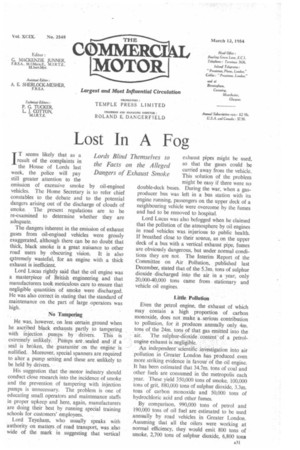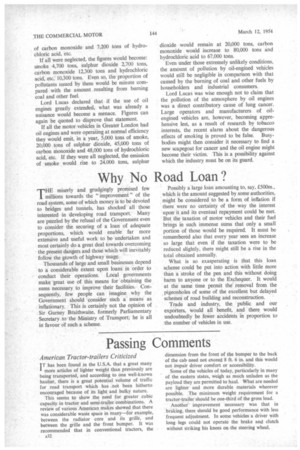Lost In A Fog
Page 33

Page 34

If you've noticed an error in this article please click here to report it so we can fix it.
IT seems likely that as a result of the complaints in the House of Lords last week, the police will pay still greater attention to the emission of excessive smoke by oil-engined vehicles. The Home Secretary is to refer chief constables to the debate and to the potential dangers arising out of the discharge of clouds of smoke. The present regulations are to be re-examined to determine whether they are adequate.
The dangers inherent in the emission of exhaust gases from oil-engined vehicles were grossly exaggerated, although there can be no doubt that thick, black smoke is a great nuisance to other road users by obscuring vision. It is also eixtremely wasteful, -for an engine with a thick exhaust is inefficient.
Lord Lucas rightly said that the oil engine was a masterpiece of British engineering and that manufacturers took meticulous care to ensure that negligible quantities of smoke were discharged. He was also correct in stating that the standard of maintenance on the part of large operators was high.
No Tampering He was, however, on less certain ground when he ascribed black exhausts partly to tampering with injection pumps by drivers. This is extremely unlikely. Pumps are . sealed and if a seal is broken, the guarantee on the engine is nullified. Moreover, special spanners are required to alter a pump setting and these are unlikely to be held by drivers.
His suggestion that the motor industry should conduct close research into the incidence of smoke and the prevention of tampering with injection pumps is unnecessary. The problem is one of educating small operators and maintenance staffs in proper upkeep and here, again, manufacturers are doing their best by running special training schools for customers' employees.
Lord Teynham, who usually speaks with authority on matters .of road transport, was also wide of the mark in suggesting that vertical exhaust pipes might be used, so that the gases could be carried away from the vehicle. This solution of the problem might be easy if there were no double-deck buses. During the war, when a gasproducer bus was left in a bus station with its engine running, passengers on the upper deck of a neighbouring vehicle were overcome by the fumes and had to be removed to hospital.
Lord Lucas was also befogged when he claimed that the pollution of the atmosphere by oil engines in road vehicles was injurious to public health. If breathed close to their source, as on the upper deck of a bus with a vertical exhaust pipe, fumes are obviously dangerous, but under normal conditions they are not. The Interim Report of the Committee on Air Pollution, published last December, stated that of the 5.3m. tons of sulphur dioxide discharged into the air in a year, only 20,000-40,000 tons came from stationary and vehicle oil engines.
Little Pollution Even the petrol engine, the exhaust of which may contain a high proportion of carbon monoxide, does not make a. serious contribution to pollution, for it produces annually only 4m. tons of the 24m. tons of that gas emitted into the air. The sulphur-dioxide content of a petrolengine exhaust is negligible • An independent scientific investigation into air • pollution in Greater London has produced even more striking evidence in favourof the oil engine. It has been estimated that 34.7m. tons of coal and other fuels are consumed in the metropolis each year. These yield 350,000 tons of smoke, 100,000 tons of grit, 880,000 tons of sulphur dioxide, 3.3m. tons of carbon monoxide and 50,000 tons of hydrochloric acid and other fumes.
By comparison, 990,000 tons of petrol and 190,000 tons of oil fuel are estimated to be used annually by road vehicles in Greater London. Assuming that all the oilers were working at normal efficiency, they would emit 800 tons of smoke, 2,700 tons of sulphur dioxide, 6,800 tons of carbon monoxide and 7,200 tons of hydrochloric acid, etc.
If all were neglected, the figures would become: smoke 4,700 tons, sulphur dioxide 2,700 tons, carbon monoxide 12,300 tons and hydrochloric acid, etc; 10.300 tons. Even so, the proportion of pollutants issued by them would be minute compared with the amount resulting from burning coal and other fuel.
Lord Lucas declared that if the use of oil engines greatly extended, what was already a nuisance would become a menace. Figures can again be quoted to disprove that statement.
If all the motor vehicles in Greater London had oil engines and were operating at normal efficiency they would emit, in a year, 5,000 tons of smoke, 20,000 tons of sulphur dioxide, 45,000 tons of carbon monoxide and 48,000 tons of hydrochloric acid, etc. If they were all neglected, the emission of smoke would rise to 24.000 tons, sulphur dioxide would remain at 20,000 tons, carbon monoxide would increase to 80,000 tons and hydrochloric acid to 67,000 tons.
Even under those extremely unlikely conditions, the amount of pollution by oil-engined vehicles would still be negligible in comparison with that caused by the burning of coal and other fuels by householders and industrial consumers.
Lord Lucas was wise enough not to claim that the pollution of the atmosphere by oil engines was a direct contributory cause of lung cancer. Large operators and manufacturers of oilengined vehicles are, however, becoming apprehensive lest, as a result of research by tobacco interests, the recent alarm about the dangerous effects of smoking is proved to be false. Busybodies might then consider it necessary to find a new scapegoat for cancer and the oil engine might become their victim. This is a possibility against which the industry must be on its guard.




































































































